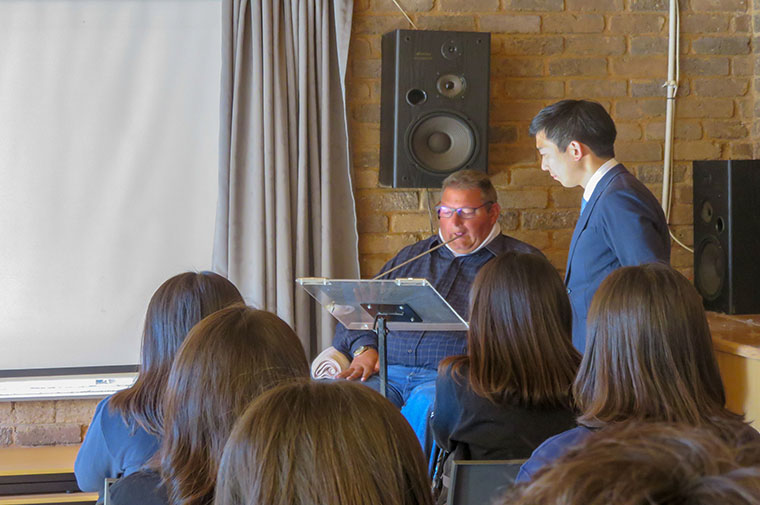“African Studies” is a program in which students from Tamagawa Gakuen learn about poverty and human rights in Africa through actual field study. This year, 20 first and second grade students visited the Republic of South Africa for nine days from July 23rd to 31st.

On the first day, the students visited the illegal settlement district in Cliptown.
There were houses where the roofs were broken and six people lived in a small hut only as big as 6 tatami mats and so on. The students were surprised at how fast the landscape changed as they travelled.
The students were shocked by the living conditions which was so different from theirs.
The reactions of the students included statements like “It is not so much that I want what I do not have, but I am thankful for what I have. I realized that is important.” “I never thought they were living a different life though they were human beings just like us … I felt like I want to help them”
With people from the support group “Cliptown Youth Program”, which provides educational opportunities for children, the students met children from the area. They did things like holding hands and playing soccer. From the innocent smiles of the children, the students felt hope.

On the second day, the students went to the JICA Pretoria branch. The students received lectures on JICA’s activities from the staff there.
Efforts to reduce local poverty problems and solutions were discussed. Additionally, how the diverse group of staff members got along was explained. The students talked with workers who actually went into the field and began to develop an image of what they could do if they worked overseas.

After the lecture, the students visited the Remme-Los Selfhelp Centre which was a JICA-supported disabled persons independence support center.
Students listened to Mr. Piet de Wit, Director of the Center, who spoke on the importance of supporting disabled people while they also supported each other and how non-handicapped people could engage with disabled people.

The next day, the students took a tour of the world heritage site at the “Sterkfontein caves”, which is called the birthplace of humanity. They were able to soak in a sense of being an explorer
They visited caves where there are the fossils that proved people evolved from anthropoids to modern humans. They received a great impression of the vastness of history by seeing the various fossils and underground lakes and they were overwhelmed by the spectacle.


On the fourth day, the students had intercultural exchanges with the students of St.Cyprian’s School in Cape Town.
First, the students gave presentations about things like “Machida: the city where we live”and “My favorite food”. The students prepared presentations using slideshows and also in a quiz format before they left Japan. The Saint Cyprian students found it very interesting to learn the personal details of the Tamagawa students.

While watching a traditional drumming performance the students marvelled at the co-ordination of the drummers and the rhytms and sounds they produced. They didn’t need to speak the language to understand the feeling.
While communicationg with the students of Saint Cyprian’s they were able to build bonds with people their own age who were from a different culture.

On the fifth day, in order to learn about apartheid in South Africa, the students went to the prison at Robben Island, where South Africa’s first Afro-Afrian president Nelson Mandela was imprisoned.
They heard from the interpreter at the site: “There was also racial discrimination over the amount charged for meals, but the prisoners actually shared meals and got around it”
“In this prison where many people were held as political prisoners, a lot of discussions were held on the course the country should take after apartheid.”
While listening to the commentary of the guide, the students felt the indomitable spirit of finding hope even among the difficulties of discrimination.


After that, the students visited a residential area. A “township” where native South Africans were forced to live under the policy of racial segregation called apartheid.
Shanties made of cloth, tinplate, car tires and lined the narrow streets. The students saw the tragic facts of life there which they had only read about in books before they arrived in South Africa.
The students interacted with children who lived in a local orphanage. They spoke of their dreams for the future innocently and played happily even while living in such a harsh environment. The students felt the energy and possibilities in each of them.

On the last day, the students visited the Cape of Good Hope located at the southwest tip of Africa.
At the Cape of Good Hope, the students were amazed by the scenery and the spectacle of nature. That day concluded their nine day adventure.

Realizing it was over the students had comments like:
“I think we should consider what we can do to help as high school students living in Japan now that we know situation there and the reality of the gap between the rich and the poor.”
“I will appreciate my normal life and share this experience with people back in Japan. I want to more people to learnabout the current situation in Africa.”
The students’ impressions were full of the passion that the students wanted to take action in the future.

While seeing the facts with their own eyes they were able to understand the challenges in Africa. On the other hand, the students also saw the brightness and resilience of the local people. The students were able to develop a mentality that may help them take steps to help out around the world as they grew older.



